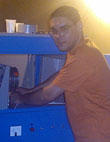|
|
 
|
|
Author
|
Topic: changeover booth plan/blueprint
|
|
|
|
|
|
|
|
|
|
|
|
|
|
|
Hugh McCullough
Expert Film Handler

Posts: 147
From: Old Coulsdon, Surrey, UK
Registered: Jan 2003
|
 posted 08-28-2007 12:15 PM
posted 08-28-2007 12:15 PM





Stephen.
The UK fire regulations stated that there had to be a separate non-sync room, if possible, as 78 rpm records were made of shellac, and were supplied, and stored, in a paper sleeve.
This combination was deemed to be a fire hazard.
Although a twin turntable was used,
(see http://www.cinephoto.co.uk/complete_projectionist_1949_non_sync.htm)
two projectionists were needed.
Some local adverts were silent, and when running these the second projectionist was required to operate the non-sync. Silence was not an option.
Naturally, during intervals only one operator was required.
Many a boring time, as a junior, have I spent alone in the non-sync room changing 78 rpm records, and the selection had to be suitable music to go with the film.
Vocals were not allowed. It was unshowmanlike to have to fade a record in the middle of a song
| IP: Logged
|
|
Stephen Furley
Film God

Posts: 3059
From: Coulsdon, Croydon, England
Registered: May 2002
|
 posted 08-28-2007 01:04 PM
posted 08-28-2007 01:04 PM




quote: Hugh McCullough
Some local adverts were silent, and when running these the second projectionist was required to operate the non-sync. Silence was not an option.
Ah, that explains why a port was needed in the non-sync room, so the operator could see the screen.
I remember on my first projection room visit, aged six, being surprised by a number of things; firstly, being led out of the building to get to it, I knew nothing of nitrate film or fire regulations at the time, secondly, the mecury arc rectifiers which facinated me, I'd never seen anything like them before, and thirdly the number of rooms involved; I thought there would just be a single room with a couple of projectors in it, though I had no idea what a film projector might look like until I went up there and saw them.
quote: Hugh McCullough
(see http://www.cinephoto.co.uk/complete_projectionist_1949_non_sync.htm)
two projectionists were needed.
Hugh, that second link seems to be broken.
I actually managed to get to Old Coulsdon a few weeks ago, I stayed on the '60' bus for a few extra stops on my way home, but just as I got there it started raining hard, so I just stayed on the bus and went home again.
| IP: Logged
|
|
|
|
|
|
Stephen Furley
Film God

Posts: 3059
From: Coulsdon, Croydon, England
Registered: May 2002
|
 posted 08-28-2007 04:55 PM
posted 08-28-2007 04:55 PM




quote: Mark Gulbrandsen
Yes, the base typically has a larger footprint but not necessarily by much in terms of square footage if you take into consideration that the lamphouse is integral in most digital projectors. In an all digital facility you loose the platters and gain alot of square footage to utilize.
Our NEC takes just about the same floor space as a 35mm machine, but I think most digital projectors are somewhat larger. However, I think there are a coiple of other points which need to be considered:
If installing the digital projector at an existing port then the floor space occupied may not be in the same position as it would be for a film projector installed at the same port. For example, on the NEC the lens is towards the left when facing the screen, and therefore if the lens is in the same position then the projector itself would extend further to the right than a 35mm machine would, but not as far to the left.
The positions required to gain access for maintenance on the digital machine may be different, and may differ from one model to another. Also, the amount of space required for access may be different on different models.
A digital projector will almost certainly take less floor space than a 35mm machine with a tower or a platter, or a pair of 35mm machines, not forgetting rewind bench, make-up table, film storage, etc. However, for many cinemas, including just about all that do not show 100% mainstream content, removing film and going totally digital is simply not an option now, or in the foreseeable future. Installing digital alongside the existing film equipment is obviously going to require more space than before. I know of several cinemas where this has caused problems.
If a video projector was previously installed, then it may be possible to remove this without any loss of facility, since video can probably be shown on the digital machine.
| IP: Logged
|
|
|
|
|
|
All times are Central (GMT -6:00)
|
|
Powered by Infopop Corporation
UBB.classicTM
6.3.1.2
The Film-Tech Forums are designed for various members related to the cinema industry to express their opinions, viewpoints and testimonials on various products, services and events based upon speculation, personal knowledge and factual information through use, therefore all views represented here allow no liability upon the publishers of this web site and the owners of said views assume no liability for any ill will resulting from these postings. The posts made here are for educational as well as entertainment purposes and as such anyone viewing this portion of the website must accept these views as statements of the author of that opinion
and agrees to release the authors from any and all liability.
|

 Home
Home
 Products
Products
 Store
Store
 Forum
Forum
 Warehouse
Warehouse
 Contact Us
Contact Us




 Printer-friendly view of this topic
Printer-friendly view of this topic





![[Frown]](frown.gif)





![[Wink]](wink.gif) .
.



